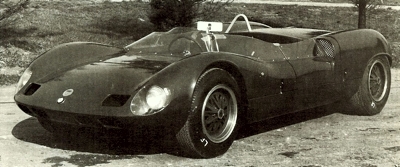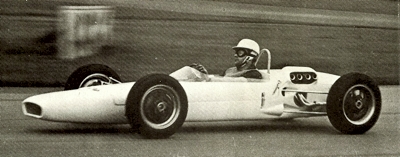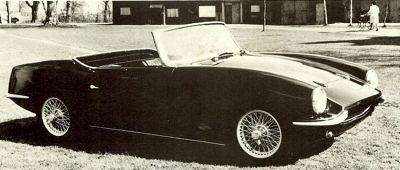|
Elva
|
1955
- 1969 |
Country: |
 |
|
It wasn't long wafter World War 2 that Frank Nichols opened a garage in Bexhill-on-Sea, Sussex, where he specialised in sporting machinery. He had a short competition career himself but then decided to go into car manu- facture. His first car-called the CSM Special, after his garage, Chapman Sports Motors-was a Ford Ten-engined two-seater.
It showed some promise, so Nichols decided to form a separate company to build sports-racing cars. This was called Elva Engineering, the name Elva being a contraction of the French 'elle va' - she goes. The first Elva was produced in 1955, a smart two-seater with all-enveloping aluminum body- work.
The chassis was of the multi-tubular type pioneered in Britain by Lotus, but the other mechanical components were an amalgam of standard and modified production-car parts, as the British racing- car industry had not yet got into full swing.
Engine Tuner Harry Weslake
The engine was the ubiquitous Ford Ten unit cleverly modified to use overhead-inlet valves instead of side valves. This conversion was designed in conjunction with the respected engine tuner Harry Weslake, who worked nearby at Rye, and it was to become a very popular conversion both for racing and road cars.
Two examples of this car were built and raced with some success, and soon orders began to trickle in from racing drivers. A Mk 1B model, which incorporated a number of improvements, was built during 1956, and in 1957 the Mk 2 was announced.
Most Used The Coventry Climax
Although different engines could be fitted, the Mk
1B and 2 were usually supplied with the popular 1098 cc Coventry Climax engine, mated to a four-speed MG gearbox. The Mkz became one of the fastest small- capacity sports cars in Britain, especially in the hands of Archie Scott-Brown who won a number of races with the car, and established class lap records.
Sales of the Elva Mk 1B and Mk 2 soared, especially in the USA where a number of drivers bought them and won plenty of races in the Sports Car Club of America racing series. A process of steady development was now undertaken and the Mk3 featured a neat proprietary glass-fibre all-enveloping body which was cheaper and easier to make than the hand-made bodies.
The Elva Mk3 retained the Coventry Climax engine, although Archie Scott-Brown raced a works car fitted with the complicated Butterworth flap-valve engine, which proved to be powerful but unreliable. The Mk 4 of 1958 was a radical departure from the Mk 2 and 3 designs as the de Dion rear suspension was abandoned in favour of a pure independent system using transverse box section radius arms, with the tubular drive shaft acting as the upper locating member.
The drum brakes were mounted inboard, adjacent to the differential, as on the Mk 2, and the remainder of the specification was similar to the Mk2 and 3 except that plenty of weight had been saved. It featured an aluminum body and was again powered by the Coventry Climax engine, mated to the a gearbox, but some owners fitted MG or Ford engines.
The Elva Courier
By 1958, Nichols was receiving constant enquiries about the possibility of building a road-going sports car, mainly from America where the importers were very keen. So he designed and produced the Courier in a very short space of time. This car featured a twin-tube chassis frame with 2½ in diameter main logitudinal tubes, and cross bracing members of It in tubing; additional small tubing superstructures were fitted for the front suspension, scuttle and rear suspension.
The front suspension was by Elva-manufactured double wishbones and coil springs, while a Wolseley 1500 rear axle was fitted, suspension being by coil spring/damper units with location by twin trailing arms and a Panhard rod. Lockheed drum brakes were fitted on all four wheels, rack and pinion steering from the Morris Minor was used and the power unit was the BMC 'B' series engine used in the MGA; originally a 1489 cc version was used but this was later increased to 1588 cc, in which form this four-cylinder unit gave around 70 bhp. It was mated to the standard four speed MG gearbox.
The prototype was built with an aluminum body but it was decided to use glassfibre for production models and Elva set up a glassfibre shop at the factory. This attractive-looking car was an immediate hit in the USA and sales were restricted to export markets for some time, but it eventually became available in Britain where it was marketed as a kit car, and again attracted a favourable reaction. Many owners ended up turning the Courier into a racing machine and it became a very popular car in American production-car racing where it set many drivers on their racing careers.
 Pictured above is the Elva 160XS, but despite its good looks only 3 would be built. Two were powered by a BMW 1800 engine, while the 3rd was fitted with a 3.5 liter Buick engine.
Pictured above is the Elva 160XS, but despite its good looks only 3 would be built. Two were powered by a BMW 1800 engine, while the 3rd was fitted with a 3.5 liter Buick engine.
 The Elva Mk.8 used a BMW 2 liter unit, and proved successful in British club racing.
The Elva Mk.8 used a BMW 2 liter unit, and proved successful in British club racing.
 The Elva Forumla Junior of 1962 was powered by a Cosworth tuned Ford Anglia engine. The car, however, was never a success and the company stopped manufacturing single seaters the following year.
The Elva Forumla Junior of 1962 was powered by a Cosworth tuned Ford Anglia engine. The car, however, was never a success and the company stopped manufacturing single seaters the following year.
 Elva's most successful model was the Courier sports, which was powered by a BMC B-Series engine. It was a big hit in the USA, with many finding their way to the race track.
Elva's most successful model was the Courier sports, which was powered by a BMC B-Series engine. It was a big hit in the USA, with many finding their way to the race track. |
Mark Donohue Takes The US Road Racing Championship
Mark Donohue, who later won the Indianapolis 500 and many other races, won the US Road Racing Championship in an Elva Courier at the start of his career. On the racing side, the Mk 5 succeeded the Mk 4 in 1959,· the design being fairly similar apart from bodywork changes, but a more important step was a single-seater derivative of the Mk 5 for the then new Formula Junior. This car was one of the first cars ready for the new Formula; like all other Elvas, it was front-engined, although the trend was towards rear engines, but the space frame chassis was neatly made and, with its attractive mini-van wall body, it gained a lot of attention when it first raced at Snetterton in April.
Threlfall is killed at Aix-Les-Bains
The car gained a few good wins and orders began to pour in, especially from America. The two-stroke DKW engine was showing-up well on the Continent and Nichols procured a number of these for his FJ cars, but it was a troublesome unit as it was difficult to cool properly. Although Chris Threlfall gave the car some good wins, it tended to lose ground to more modem rear-engined makes, especially after Threlfall was killed in a race at Aix-Les-Bains. Despite the car's ultimate eclipse, Elva sold over 150, largely because it was readily available as a kit of parts.
The company went through financial problems in 1961 and, out of the crisis, a new company called Elva Cars (1961) Ltd was formed. A new rear-engined Formula Junior car was designed for the 1961 season and, for the first time, a rear-engined sports/racing car, the Mk 6, was announced. Both cars were available with the Cosworth-modified Ford Anglia engines, the sports car gaining a number of wins and selling in fair quantities; but the FJ car was a relative failure and, by 1962, Elva had virtually abandoned building single-seater racing cars.
The Elva Mk. 7 Racer
The Courier was selling well but its production took up a great deal of time so, in 1962, Nichols made an agreement with Trojan Ltd of Purley, Surrey for them to build the car under licence. Nichols was then free to concentrate on racing cars and, for 1963, he produced the Mk 7 sports/racing car which retained many features from the Mk 6. A variety of engines could be ordered; the FW A Coventry Climax engine was still popular but the Mk 7 was also available with the Cosworth-Ford 1100 cc unit or the Twin-Cam, Cosworth-Ford It-liter unit. Using this latter engine, Bill Moss won a number of races in the works car.
For 1964, the Mk 8 Elva was produced; it remained much the same as the Mk 7 but it was available with a wide range of engines from a 997 cc Ford Anglia up to the 2-liter BMW and Porsche engines and, with a Porsche unit, Herbert Muller finished a close second in the European Mountain Championship to the factory Porsche of Edgar Barth. In Britain, the BMW unit was most popular and this 2-liter unit, when tuned by Frank Webb, gave around 190 bhp. This was sufficient to give Tony Lanfranchi many wins in British club races.
The Elva 160XS by Fiore
A large number of Mk 8s were sold and private owners gained many successes around the world. A road version of the Mk 8, known as the 160XS, with bodywork designed by Fiore, was marketed, but only three cars were produced. By 1964, the Trojan Group had taken over the whole of the Elva concern, and production of the racing cars was eventually moved to the Purley factory, although Nichols remained as a consultant. A deal was made with Bruce McLaren for Trojan to build the New Zealander's new Oldsmobile-powered sports car under the name McLaren-Elva in order to cash in on the good name that Elva had built up in the USA.
Demand for the Courier was beginning to run down despite the fact that Trojan developed a handsome new sports body in 1964, together with an improved chassis and the option of the 1½-liter Ford engine as an alternative to the MGB 1.8-liter unit. This model had independent rear suspension by double wishbones and a new occasional four-seater coupe was also announced. A sports/racing version called the Sebring was announced, this version having a lightweight body, magnesium wheels, a limited slip differential, and the option of highly-tuned Cosworth-Ford or MGB engines. But it, too, had little success and in 1966 Trojan sold the Courier project to Ken Sheppard Customised Sports Cars of Radlett.
Ken Sheppard Customised Sports Cars
Ken Sheppard Customised Sports Cars continued production spasmodically until 1969, when the remaining spare parts were sold to Tony Ellis of Windsor. One last ditch effort was made with the introduction of a 3-liter, high performance coupe called the Cougar. It was powered by a Ford V6 engine with a Minnow-Fish-type carburetor which enabled the car to reach 130 mph and accelerate to 100 mph in just over 20 seconds. The Cougar was styled very much in the 1950s tradition, resembling early Bristol models.
Perhaps this was the deciding factor that killed Elva: the car never caught on, and Tony Ellis concentrated on a spares and repair service until 1973. The Elva name finally died for good in 1969 and Frank Nichols returned to his garage and general engineering business after a colourful, if short, life as a racing car manufacturer.
